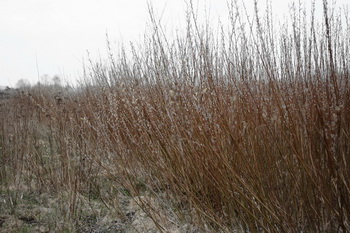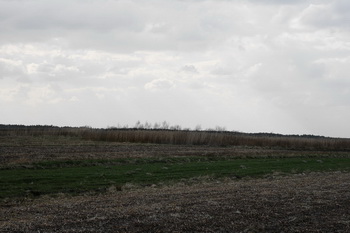Willow cultivation
Wickerwork
Willow cultivation
Elements shaping the process of willow growth and harvesting.
 In order for wicker products to be beautiful and lasting, the willow must be cultivated in the proper conditions; the first of such conditions is proper climate, the second – proper soil, and the third, proper irrigation of the willow fields. The climate includes lighting conditions, heat, and the amount of precipitation. A change in any one of these three factors while the crops are growing will cause changes in the anatomy and physiology of the crops. For willow, the most important are precipitation conditions, since willow crops take in more water than other crops.
In order for wicker products to be beautiful and lasting, the willow must be cultivated in the proper conditions; the first of such conditions is proper climate, the second – proper soil, and the third, proper irrigation of the willow fields. The climate includes lighting conditions, heat, and the amount of precipitation. A change in any one of these three factors while the crops are growing will cause changes in the anatomy and physiology of the crops. For willow, the most important are precipitation conditions, since willow crops take in more water than other crops.
A second element that affects the final wicker products is the soil. Soil is important because of its connection with the root system, and because of the minerals it contains. The best types of soil are riverside, midfield soil and forest soil, though even uncultivated soil would also be okay for undemanding willow plants. To reap the best harvest, however, soils falling under the III, IV, and V categories of the soil quality classification are suggested. Willow is not a demanding crop when it comes to energy-consumption, or, in other words, the need for fertilizer and pesticides. It likes well-weeded areas that are sufficiently cultivated and properly tilled. Willow seedlings are planted in spring, so the work needs to be started early enough that it is completed by the final days of April.
The most commonly cultivated species of willow
Among the most eagerly cultivated species of willow are the American Willow, the Common Osier, the Almond Willow, and the Purple Willow. The American Willow is at present the most commonly cultivated because it is the best for weaving. Its relatively thin branches are unusually pliable, flexible, less likely to snap, and immune to so-called “*”. It is also characterized by its hard, white wood, its small layer of pith, and the ease with which it can be stripped. Though it degenerates more quickly than the Common Osier, it is more eagerly and more frequently cultivated in Poland, and makes up about 75% of the crops on willow plantations.
The Common Osier, on the other hand, and its many varieties is very good for energetic, industrial, and – above all – weaving purposes. They make up about 20% of the overall willow cultivation. Like the American Willow, it is most often used for basketry. The Almond Willow is characterized by its flaky, protruding bark on old trunks. It also has many subspecies and varieties that are used for weaving. It is relatively thin, immune to twisting, bending, and snapping. In certain regions of France and Germany it is valued more highly than the American Willow. The Purple Willow goes by many different names, among others: “red,” “sandy,” and “string.” What is characteristic about it is that it is grown along the periphery of plots of other willow crops because its branches have a bitter taste to them, which keeps forest animals away. This type of willow has thin, smooth, and flexible branches. Like the Common Osier and American Willow, there are many varieties of the Purple Willow that are used in the most delicate weaves.
Other species of willow are also used in the weaving of baskets, chairs, furniture, mats, fences, and other items; these include the White Willow, Gray Willow, Rosemary Willow, Laurel Willow, Crack Willow, Salix dasyclados, Violet Willow, Sharpleaf Willow, and the Goat (or Pussy) Willow.
Planting
 It is important that the density of the willow crops be proper, for if they are planted too closely together weeds will spring up and the harvest will be smaller. That is why setting up plantations on narrower strips of farmland is suggested. The optimal density turns out to be 220,000 seedlings (40 x 12 cm) per hectare for species meant for the production of one-year rods. Of course, granted that good chemical and mechanical care will be provided, and 125,000 (40 x 20 cm) per hectare, for species meant for three-year use. It is also not recommended to plant the crops below the surface of the soil. On the other hand, during manual or mechanical cultivation, one must remember that the tip of the seedling should stick about 2 cm out above the surface of the ground.
It is important that the density of the willow crops be proper, for if they are planted too closely together weeds will spring up and the harvest will be smaller. That is why setting up plantations on narrower strips of farmland is suggested. The optimal density turns out to be 220,000 seedlings (40 x 12 cm) per hectare for species meant for the production of one-year rods. Of course, granted that good chemical and mechanical care will be provided, and 125,000 (40 x 20 cm) per hectare, for species meant for three-year use. It is also not recommended to plant the crops below the surface of the soil. On the other hand, during manual or mechanical cultivation, one must remember that the tip of the seedling should stick about 2 cm out above the surface of the ground.
Care
Taking proper care of the plantation is essential, especially in the first phase (that is, during the first year after planting, but not only), because attending to the willow affects its quality and the later wicker products that are to be made from it. For this reason, the following factors should be taken into account: the ridding of weeds and the tilling of the soil. Willow is a crop that likes a good amount of sunlight, enough water, and access to the nutrients to be found in the soil. A regular “de-weeding” is important, since weeds limit young sprouts access to valuable sources. That is also the reason that neglecting or delaying the first hoeing of the ground may lead to large losses during the harvest. Protection against pests and disease. Damage may be caused by insects, mushrooms, disease, frost, or hail. Two of the most dangerous are surely frost and hail. Frost causes small wounds on the bark of the willow, which become visible only after about two weeks. Hail, on the other hand, and its blows generally reach the pith itself, causing the rod to become brittle and thus disqualifying it when it comes to further processing or wickerwork. Frequent spring ground-frosts make the tips of the willow rods wilt. If the frost is unusually fierce the shoots dry up and the plant releases side offshoots lowering the quality of the rod. The most common willow diseases are: willow leaf rust, a bacterial wilting of the shoots, willow scab, and anthracnose. The planting of more crops later. You need to be prepared for the possibility that around 20% of the seedlings will not take root, so remember this deficiency and add more crops, bearing in mind the growth of side shoots and the speed of this growth.